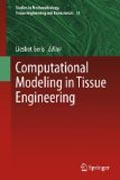
One of the major challenges in tissue engineering is the translation of biological knowledge on complex cell and tissue behavior into a predictive and robust engineering process. Mastering this complexity is an essential step towardsclinical applications of tissue engineering. This volume discusses computational modeling tools that allow studying the biological complexity in a more quantitative way. More specifically, computational tools can help in: . (i) quantifying and optimizing the tissue engineering product, e.g. by adapting scaffold design to optimize micro-environmental signals or by adapting selection criteria to improve homogeneity of the selected cell population;.(ii) quantifying and optimizing the tissue engineering process, e.g. by adapting bioreactor design to improve quality and quantity of the final product; and .(iii) assessingthe influence of the in vivo environment on the behavior of the tissue engineering product, e.g. by investigating vascular ingrowth.The book presents examples of each of the above mentioned areas of computational modeling. The underlying tissue engineering applications will vary from blood vessels over tracheato cartilage and bone. For the chapters describing examples of the first two areas, the main focus is on (the optimization of) mechanical signals, mass transport and fluid flow encountered by the cells in scaffolds and bioreactors aswell as on the optimization of the cell population itself. In the chapters describing modeling contributions in the third area, the focus will shift towards the biology, the complex interactions between biology and the micro-environmental signals and the ways in which modeling might be able to assist in investigating and mastering this complexity. The chapters cover issues related to (multiscale/multiphysics) model building, training and validation, but also discuss recent advances in.
- ISBN: 978-3-642-32562-5
- Editorial: Springer
- Encuadernacion: Cartoné
- Fecha Publicación: 30/09/2012
- Nº Volúmenes: 1
- Idioma: Inglés
